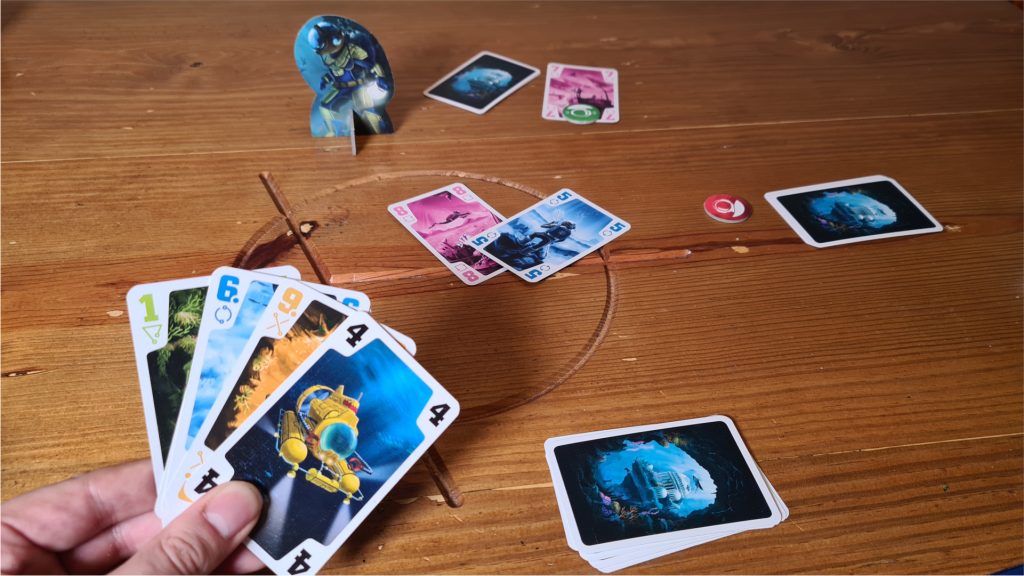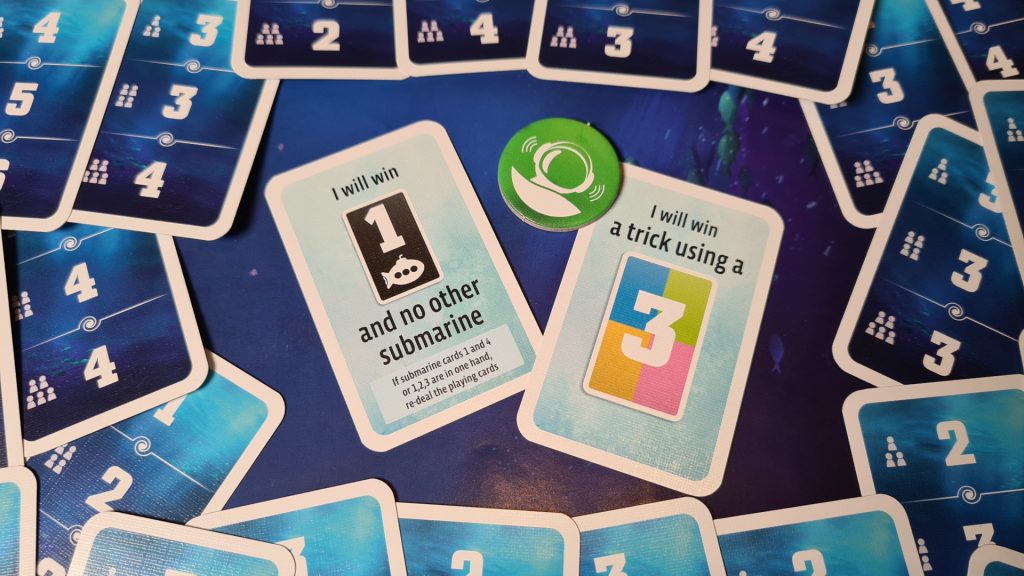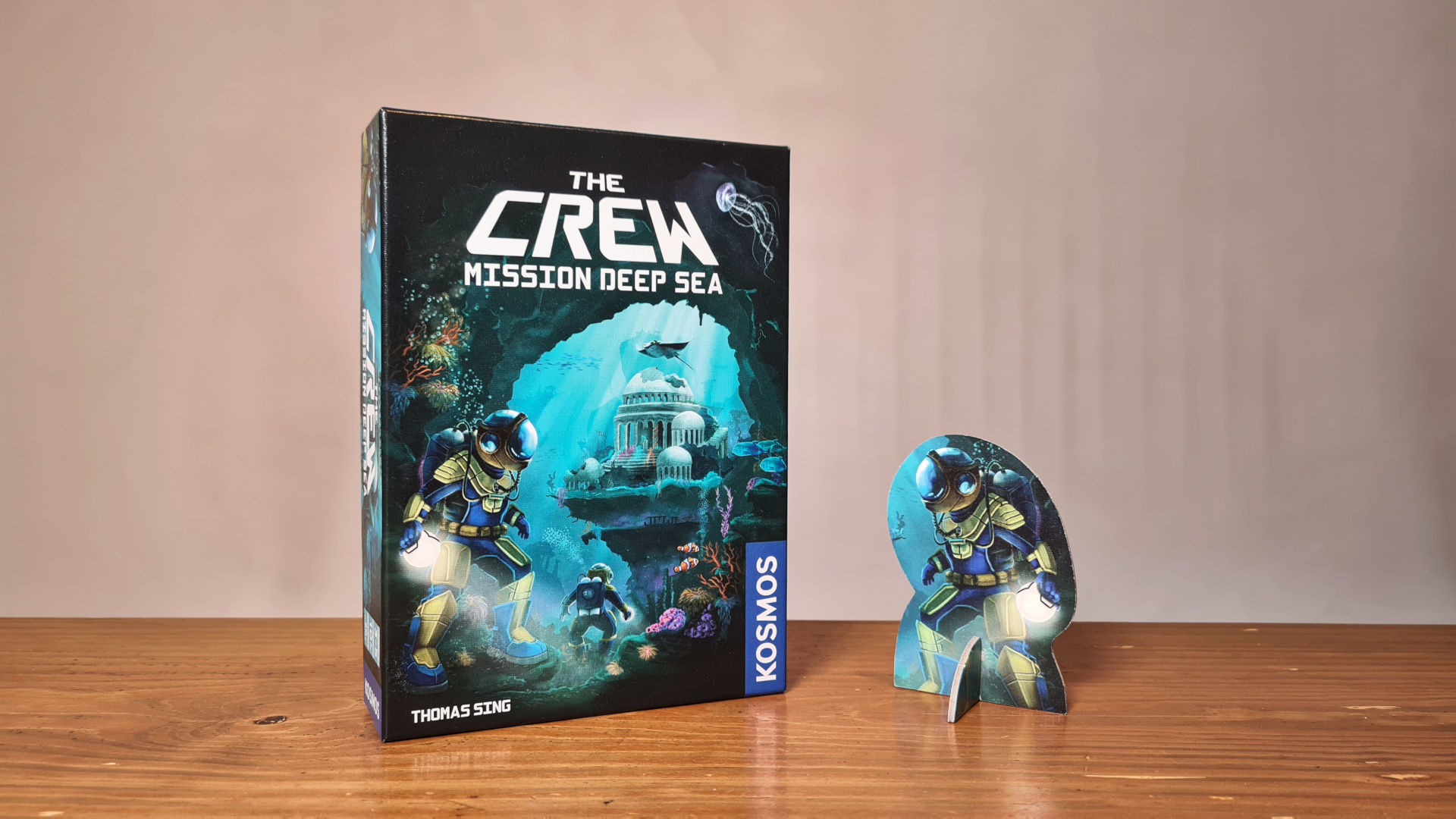The Crew Mission Deep Sea is the brand new co-operative trick-taking game from publisher KOSMOS. Designed by Thomas Sing, featuring artwork from Marco Armbruster, the game sees 2 – 5 players spend between 5 – 20 minutes trick taking but not always wanting to win tricks of cards. Being cooperative the players may want to not win a single green card, or perhaps just the green 7, as the missions from the deep sea dive are accomplished. However, is The Crew Mission Deep Sea better than the original? Let’s find out!
For those who haven’t played The Crew The Quest For Planet Nine, at the start of each game the entire deck of cards is shuffled and evenly dealt out to players. The deck is made up of four coloured suits (pink, green, blue and yellow) numbered 1 – 9 and special submarines numbered 1 – 4. It will be with these cards that players will be trying to win and lose tricks. Importantly, communication in the deep sea is limited, though for the early missions players get a single communication token each.
Before the round begins a number of goal cards are put in the middle of the table. The amount and difficulty of these cards is based upon two factors: the number of players around the table and mission you are currently on in the logbook. These missions range from needing to win specific numbered cards in a trick, perhaps winning a submarine or even not winning any card of a specific colour. These cards need to be chosen by the players, slowly taken as players go around the table picking one.

On a turn the starting player, initially whoever has the 4 valued submarine, chooses a card from their hand and plays it into the middle of the table. This card is the start of the trick and dictates the suit. Going clockwise around the table, each other player then plays a card from their hand to the middle, and they must follow the suit of the trick if they can. If a player can’t follow the trick they are allowed to discard a card of a different suit into the trick or play a submarine card – which trumps all normal cards.
When everyone has played a card into the trick the round is complete. If any submarines have been played the highest wins the trick. If no submarines have been played then the highest value card of the starting suit wins the trick. The player who wins the trick takes the cards, placing them in front of themselves – they will then start the next trick. This is how players win the cards, or lose to avoid winning specific cards. In normal trick taking games the way to win is simply to win these tricks but The Crew Mission Deep Sea is cooperative. The only way to win is for everyone to achieve their goal cards.
Information is limited. You won’t know what cards other players have in their hand, though you can see their goal cards in front of them. Players do have the option to give some information, at least in the early missions of the logbook. Players get a communication token that they can use to reveal a single card from their hand. This card must be their highest, lowest or only card of that suit – which is announced. This is a one time thing in the game, so players have to be careful when choosing what information to give.
Ramping up the difficulty is done by increasing the number of or difficulty rating of the task cards in play. While players are free to determine this themselves, the logbook – which is full of lore – can handle this for players. It also offers ways to tweak the game on top of just the cards. There are further limits to communication, one forces the first player to take the hardest task available and some even put a time limit on the game. The logbook adds these over time, giving the difficulty curve a natural progression rather than spikes.

The Crew Mission Deep Sea takes the missions from the original, flicking through much of the logbook and streamlines it. The deck of cards means you can get the game to the table swiftly, and the levels of the missions are easily understandable based on the number system. There is the possibility that two level 2 cards can be drastically different in difficulty, though only from the dealing of the cards – with them being clear and obvious what the objective is. A handful have slight caveats as to how something can or cannot be achieved, though these are only a few edge cases where clarity was needed and already there.
There is little to fault about the components of The Crew Mission Deep Sea. Less tokens are included compared to the original, with the large deck of task cards doing the work instead. The different difficulty levels of cards are balanced depending on the player count, with numbers on the reverse to determine the difficulty as you flick through the cards. A general colour system on the reverse from green -> red would have made it a bit quicker. The logbook is an inclusion that some groups will get a lot out of, with the flavour text for each mission. Others will flick through to determine the limitations and rules for that mission and otherwise ignore it.
For those looking for a vastly different or changed up game from the original you will be disappointed. Gameplay wise The Crew Mission Deep Sea feels much of the same, but it is the challenge and the puzzly aspects of the cooperative experience that keeps you coming back for more. Changing to a deck of objectives streamlines the journey of getting the game to the table quickly, letting it hit the ground running. Therefore for new players this is the version to get out of the two, and there’s enough for veteran players of the original to enjoy included too.
(Editor’s Note: The Crew Mission Deep Sea was provided to us for review by the publisher. More details can be found on the on the Thames and Kosmos store.)

